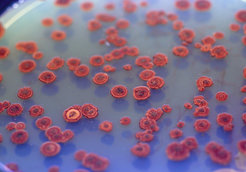Department of Natural Products in Organismic Interactions

Bacteria are like miniature factories - they produce an enormous variety of natural product classes and their derivatives. Our aim is to understand the function of these specialized metabolites (also called secondary metabolites or natural products) in complex environments, composed of different organisms, at the molecular detail in time and space:
- Which metabolite is produced at which point in the bacterial life cycle?
- How does the biosynthesis machinery work and how is it regulated?
- What are the molecular targets of specific metabolites?
- What metabolites are required to colonize a certain ecological niche?
The answers to these questions open up a multitude of possible applications, e.g. the more targeted search for microbial natural products could help to discover new drug candidates in human therapy. Although these questions can be addressed essentially in any microbe producing specialized metabolites, we use a tripartite system of model organisms. Bacteria of the genera Photorhabdus and Xenorhabdus live as gut symbionts in the intestine of soil-dwelling nematodes of the genera Heterorhabditis and Steinernema. The nematodes infect insect larvae into which they inject the bacteria, which kill the insect larvae and thus provide a food source for both bacteria and nematodes.
Despite its ecological complexity, this tripartite model system can be studied in the laboratory in different partial combinations and in all life stages. The bacteria play a central role in this system. Their most important advantage is that they can be manipulated genetically, they can be cultivated even without their nematode host and they produce various different specialized metabolites including peptides produced by non-ribosomal peptide synthetases (NRPS) – the latter are of particular interest to us.
To address the above questions, we apply a wide range of methods: natural product research to isolate and elucidate the structure of the specialized metabolites, transcriptomics, proteomics and metabolomics to identify regulatory mechanisms, and synthetic biology and genetic engineering to modify and optimize desired biosynthetic pathways.
Videos about our research
At the MPG anniversary celebrations in Göttingen, we demonstrated the function of the giant non-ribosomal peptide synthetases (NRPS) in a group performance: Link to Video
Can bacteria talk to each other, and who makes the antibiotics we need? These were the topics we discussed at the Frankfurt Kids' University:
Können Bakterien miteinander reden? 12. Frankfurter Kinder-Uni, 2014
Wer stellt eigentlich Antibiotika her? 17. Frankfurter Kinder-Uni, 2019
Our explanatory video shows how NRPS engineering works:
Synthetische Naturstoffe: Der Weg zu neuen Medikamenten?



